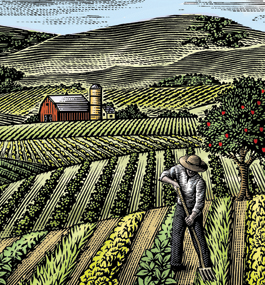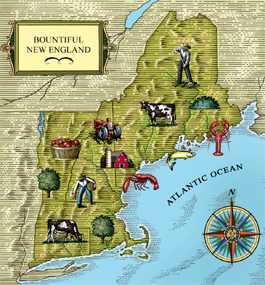Cultivating New England

Steven Noble
by Brian Donahue
The idea that we should even try to grow all our own food locally is frankly preposterous. By 1790, when its population stood at less than 1 million, New England was already importing food — in particular, grain from states farther west, not to mention sugar and rum from Barbados. Food imports by canal and coastal shipping only increased in the decades that followed, even while much of New England was virtually deforested to feed booming cities and textile mills. Our farmland couldn’t keep up then — and, as New England’s population approaches 15 million, no combination of animals, vegetables and miracles will suffice now.
But there are plenty of good reasons to move in the direction of growing more food locally, without worrying about complete self-sufficiency. The key is to learn anew what crops really do make sense to grow here, given our soils and climate. Here again, history proves instructive. What were we growing a century ago, when New England had become a thoroughly urban, industrial society?
 |
|
Sidebar Stories |
 |
The answer is surprisingly encouraging. Not all New England farmers abandoned the land when the railroad delivered a veritable flood of cheap grain from the Midwest in the years after the Civil War, as is often supposed. Most adapted and found crops for which they had a comparative advantage. Dairy farmers allowed millions of acres of degraded pasture to return to forest, while at the same time feeding that cheap grain to their cows to increase the flow of milk. New England apples and other fruits found strong urban markets, and intensive truck farming boomed around the region’s cities. If we want to contemplate what New England might profitably grow in the future, when energy will likely be much more expensive, the era that immediately preceded the age of cheap oil is worth our attention.
Today, only 5 to 7 percent of New England’s 40 million acres remains dedicated to agriculture, while a good 80 percent is forested. That recovered forest affords us a broad range of benefits: It enhances water quality, protects biodiversity, sequesters carbon to help mitigate global warming, and provides us with renewable resources and recreation. Let’s say we were committed to protecting 70 percent of the landscape in permanent forest — as indeed I am, as co-author of the “Wildlands and Woodlands” report (see author’s note). That would still allow farmland to re-expand to 6 million acres or about 15 percent of New England, close to where it stood in 1945, before the rise of industrial agriculture — or even in 1910, when New England farm production was at its peak. This bold vision of concentrated “smart growth,” combined with forest and farmland protection, provides an attractive set of interwoven social and ecological benefits and gives us an outer limit to the amount of land we might reasonably return to agricultural use.
What could we grow? First of all, we could greatly expand our fresh vegetable production and support it almost entirely on compost and recycled nutrients. Simple, energy-efficient technologies such as cold frames, glass or plastic-covered large wooden boxes that protect seedlings from chilly weather, and hoop houses, greenhouses that use plastic wrapped over flexible piping to trap solar heat, can extend the growing season for crops like salad greens. Assuming that we act to reinvigorate regional processing and preservation, we could supply just about all of our vegetables. We could reasonably grow about half of our fruit — the great bulk of that would be apples, along with cranberries and blueberries. We could also greatly expand our production of soybeans, lentils and navy beans, replacing some of the meat in our diet — a substitution universally recommended by nutritionists. All of this could be done on about 1 million acres, with a large part of the vegetable production accomplished on small holdings in and around cities.

Steven Noble
page 2 of 2
Most of New England’s farmland would be devoted to cows, as it always has been. We do not have large expanses of prime cropland in New England, but we do have plenty of rocky upland that, if properly managed, is excellent for pasture. We need to move our dairy production from grain onto a foundation of grass, because that is what ruminants should eat, for their health and ours. We could find enough grass to produce all our own milk, butter and cheese in New England. Alongside that we could produce all the beef we need — along with a little lamb – provided we cut our red meat consumption in half. This would mean more than doubling the size of our cow population and clearing a lot more land to support them — at least 4 million acres of pasture and hay. That would revive some semblance of the pastoral New England landscape that has faded in the past century — only we would need to manage it much more productively than we ever did before.
Even if we restore our pastures, we will still need to import grain into New England, both for our own consumption and for animal feed. The grain we consume directly — as bread, pasta and beer — would eat up the remaining 1 million acres of cropland. We could produce all our own pork, chicken and eggs — major sources of protein — on New England pasture farms. But even “pastured” poultry and pigs still eat mostly grain. And here’s the good news: It makes sense to import grain. Grain stores well and ships at very low cost, so there is no reason to grow more than a limited amount in New England, mostly in rotation with grass and legumes. Buying-in feed grain also provides a flow of nutrients to our farms, via manure — something farmers have always understood. Even if we eat a more vegetarian diet, we will have to bring in grain and beans. No matter how you slice it, sustainable farming in New England will always require links to sustainable farming in the Midwest.
New England could reasonably grow about half its own food, given a healthier diet, sustainable farming and a sustainable fishery — perhaps an even more daunting challenge than clearing 4 million acres of forest! Growing half our food would be a remarkable achievement. But it also reminds us not to go overboard and swear off the many wonderful imported foods — coffee, tea, oranges, bananas, wine and peanut butter, to name a few — that enrich our lives. We do not need to completely abandon foods from around the world — though we do need to pay the full environmental and social costs of producing them sustainably and bringing them here.
New England is full of innovative farmers pioneering this new version of an old food system. We only need more of them, and more land for them to farm. This could be found without putting much of a dent in the forest: It would just mean that slightly more of New England would again look like Vermont. At the same time, tens of thousands of intensively farmed acres could be recovered by the greening of our cities and suburbs — and that, too, is already happening. Just as we need to be wary of ideologues who pose false dichotomies between total local self-reliance and unswerving allegiance to global industrial agriculture, we also need to avoid abstract choices among forest, farmland and development. These are challenges that cry out for balanced, mutually reinforcing urban and rural solutions.
My students, who are acutely concerned about social justice, always ask whether sustainably grown local food can be affordable and accessible to all. That is a fair question that can only be answered by addressing the overt and hidden subsidies that make fast food so inexpensive to produce but so costly to our health and environment. Why wouldn’t we devote similar support to farming that provides a wide range of social and environmental benefits instead?
We don’t need a hopeless quest to make our region totally self-sufficient by subsisting through the lean months on nothing but parsnips and kale. We could use a targeted expansion in local production of foods that really make sense in New England, tied to parallel sustainable reforms throughout our global agricultural system. This would bless us not just with healthier food but also an attractive landscape in which to live, opportunities to reduce energy and environmental costs, and multiple chances for people to become more engaged with how their food is grown.
This vision of the future, along with the satisfaction of farming itself, is what attracts my students to local agriculture, just as it attracted me. Many of them won’t remain farmers all their lives — though some will, and they will be good ones. But more people can enjoy spending part of their lives farming and in the process take part in a form of agriculture that sustains us fully as human beings, rather than simply filling our bellies with the cheapest fuel. For me, that is the real virtue of local farming.
 |
Brian Donahue is associate professor of American environmental studies and co-editor of “American Georgics: Writings on Farming, Culture and the Land,” published by Yale University Press in 2011. Donahue also co-authored “Wildlands and Woodlands: A Vision for the New England Landscape.” Visit www.wildlandsandwoodlands.org. |
